flat tire HONDA CIVIC COUPE 2016 10.G Quick Guide
[x] Cancel search | Manufacturer: HONDA, Model Year: 2016, Model line: CIVIC COUPE, Model: HONDA CIVIC COUPE 2016 10.GPages: 82, PDF Size: 5.2 MB
Page 4 of 82
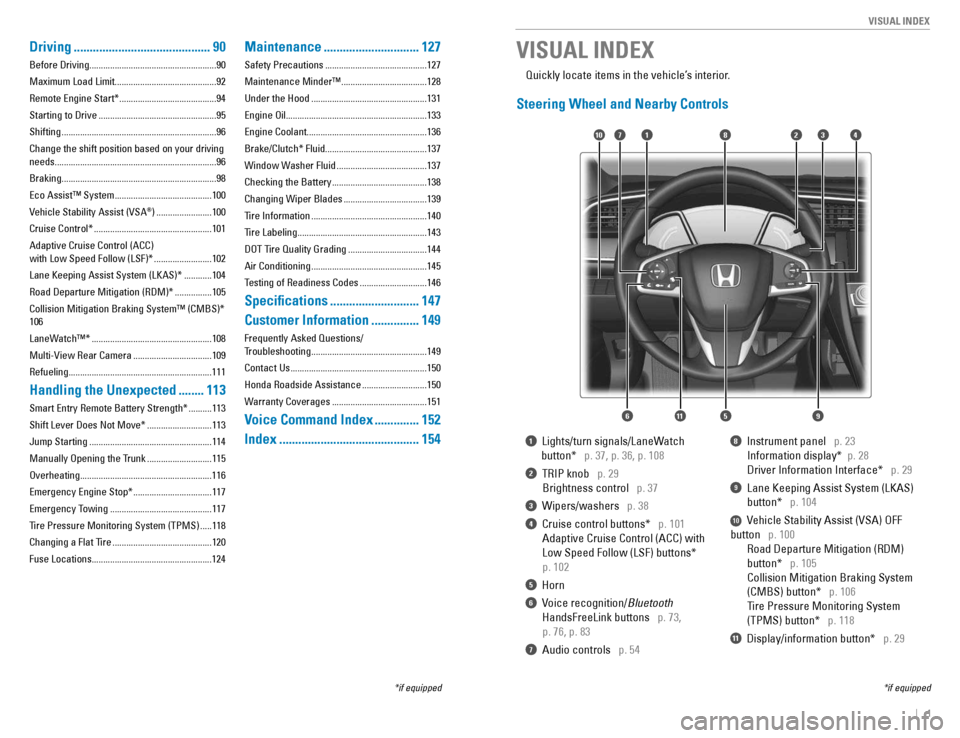
| 1
VISUAL INDEX
1 Lights/turn signals/LaneWatch
button*
p. 37, p. 36, p. 108
2 TRIP knob p. 29
Brightness control
p. 37
3 Wipers/washers p. 38
4 Cruise control buttons* p. 101
Adaptive Cruise Control (ACC) with
Low Speed Follow (LSF) buttons*
p. 102
5 Horn
6 Voice recognition/ Bluetooth
HandsFreeLink buttons
p. 73,
p. 76, p. 83
7 Audio controls p. 54
8 Instrument panel p. 23
Information display* p. 28
Driver Information Interface* p. 29
9 Lane Keeping Assist System (LKAS)
button*
p. 104
10 Vehicle Stability Assist (VSA) OFF
button
p. 100
Road Departure Mitigation (RDM)
button*
p. 105
Collision Mitigation Braking System
(CMBS) button*
p. 106
Tire Pressure Monitoring System
(TPMS) button*
p. 118
11 Display/information button* p. 29
VISUAL INDEX
*if equipped
*if equipped
Quickly locate items in the vehicle’s interior.
Steering Wheel and Nearby Controls
2
5
71310
6
48
911
Driving
........................................... 90
Before Driving.......................................................90
Maximum Load Limit............................................92Remote Engine Start* .......................................... 94
Starting to Drive ................................................... 95
Shifting ................................................................... 96
Change the shift position based on your driving
needs......................................................................96
Braking...................................................................98Eco Assist™ System .......................................... 100
Vehicle Stability Assist (VSA ®
) ........................ 100
Cruise Control* ................................................... 101
Adaptive Cruise Control (ACC) with Low Speed Follow (LSF)* .........................102
Lane Keeping Assist System (LKAS)* ............104
Road Departure Mitigation (RDM)* ................105
Collision Mitigation Braking System™ (CMBS)* 106
LaneWatch™* .................................................... 108
Multi-View Rear Camera ..................................109
Refueling..............................................................111
Handling the Unexpected ........113
Smart Entry Remote Battery Strength* ..........113
Shift Lever Does Not Move* ............................113
Jump Starting ..................................................... 114
Manually Opening the Trunk ............................115
Overheating.........................................................116 Emergency Engine Stop* ..................................117
Emergency Towing ............................................ 117
Tire Pressure Monitoring System (TPMS) .....118
Changing a Flat Tire ........................................... 120
Fuse Locations....................................................124
Maintenance .............................. 127
Safety Precautions ............................................ 127
Maintenance Minder™ .....................................128
Under the Hood .................................................. 131
Engine Oil.............................................................133
Engine Coolant....................................................136
Brake/Clutch* Fluid............................................137
Window Washer Fluid .......................................137
Checking the Battery ......................................... 138
Changing Wiper Blades ....................................139
Tire Information .................................................. 140
Tire Labeling ........................................................ 143
DOT Tire Quality Grading ..................................144
Air Conditioning .................................................. 145
Testing of Readiness Codes .............................146
Speci�cations ............................ 147
Customer Information ...............149
Frequently Asked Questions/
Troubleshooting .................................................. 149
Contact Us ........................................................... 150
Honda Roadside Assistance ............................150
Warranty Coverages ......................................... 151
Voice Command Index ..............152
Index ............................................ 154
Page 62 of 82
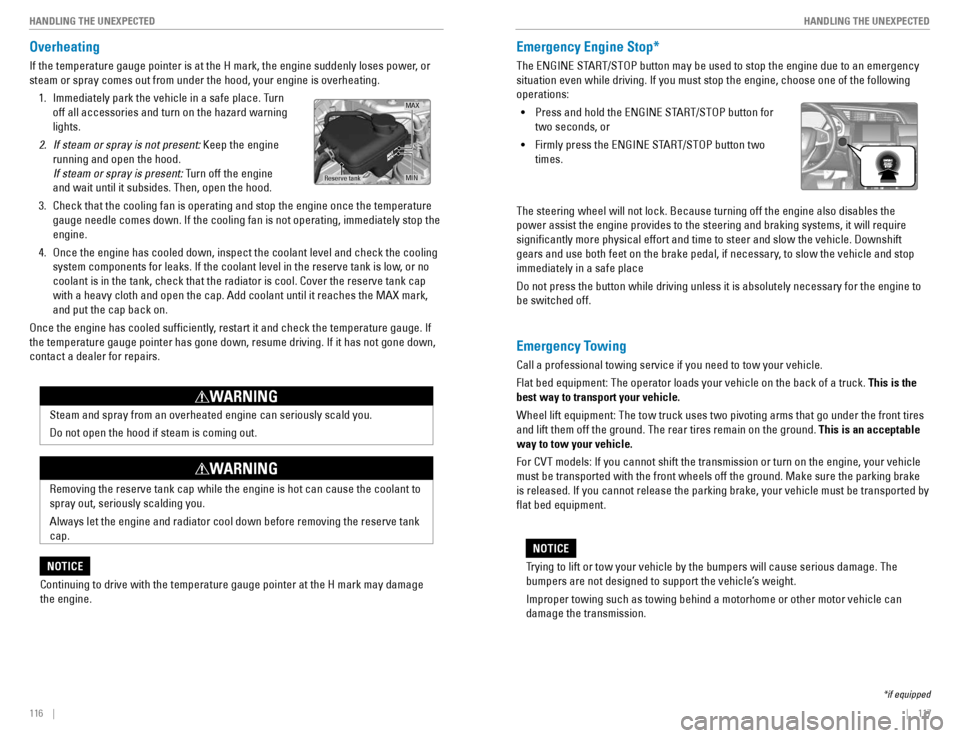
116 || 117
HANDLING THE UNEXPECTED
HANDLING THE UNEXPECTED
Overheating
If the temperature gauge pointer is at the H mark, the engine suddenly loses power, or steam or spray comes out from under the hood, your engine is overheating.
1. Immediately park the vehicle in a safe place. Turn off all accessories and turn on the hazard warning lights.
2. If steam or spray is not present: Keep the engine
running and open the hood. If steam or spray is present: Turn off the engine
and wait until it subsides. Then, open the hood.
3. Check that the cooling fan is operating and stop the engine once the temperature gauge needle comes down. If the cooling fan is not operating, immediately stop the engine.
4. Once the engine has cooled down, inspect the coolant level and check the cooling system components for leaks. If the coolant level in the reserve tank is low, or no
coolant is in the tank, check that the radiator is cool. Cover the reserve tank cap with a heavy cloth and open the cap. Add coolant until it reaches the MAX mark, and put the cap back on.
Once the engine has cooled suf�ciently, restart it and check the temperature gauge. If the temperature gauge pointer has gone down, resume driving. If it has not gone down, contact a dealer for repairs.
MAX
Reserve tankMIN
Steam and spray from an overheated engine can seriously scald you. Do not open the hood if steam is coming out.
WARNING
Removing the reserve tank cap while the engine is hot can cause the coolant to spray out, seriously scalding you. Always let the engine and radiator cool down before removing the reserve tank cap.
WARNING
Continuing to drive with the temperature gauge pointer at the H mark may damage the engine.
NOTICE
Emergency Engine Stop*
The ENGINE START/STOP button may be used to stop the engine due to an emergency situation even while driving. If you must stop the engine, choose one of the following operations:
• Press and hold the ENGINE START/STOP button for
two seconds, or
• Firmly press the ENGINE START/STOP button two
times.
The steering wheel will not lock. Because turning off the engine also disables the
power assist the engine provides to the steering and braking systems, it will require
signi�cantly more physical effort and time to steer and slow the vehicle. Downshift
gears and use both feet on the brake pedal, if necessary, to slow the vehicle and stop immediately in a safe place
Do not press the button while driving unless it is absolutely necessary for the engine to be switched off.
*if equipped
Emergency Towing
Call a professional towing service if you need to tow your vehicle. Flat bed equipment: The operator loads your vehicle on the back of a truck. This is the
best way to transport your vehicle.
Wheel lift equipment: The tow truck uses two pivoting arms that go under the front tires and lift them off the ground. The rear tires remain on the ground. This is an acceptable
way to tow your vehicle.
For CVT models: If you cannot shift the transmission or turn on the engine, your vehicle must be transported with the front wheels off the ground. Make sure the parking brake
is released. If you cannot release the parking brake, your vehicle must be transported by �at bed equipment.
Trying to lift or tow your vehicle by the bumpers will cause serious damage. The
bumpers are not designed to support the vehicle’s weight. Improper towing such as towing behind a motorhome or other motor vehicle can damage the transmission.
NOTICE
Page 64 of 82
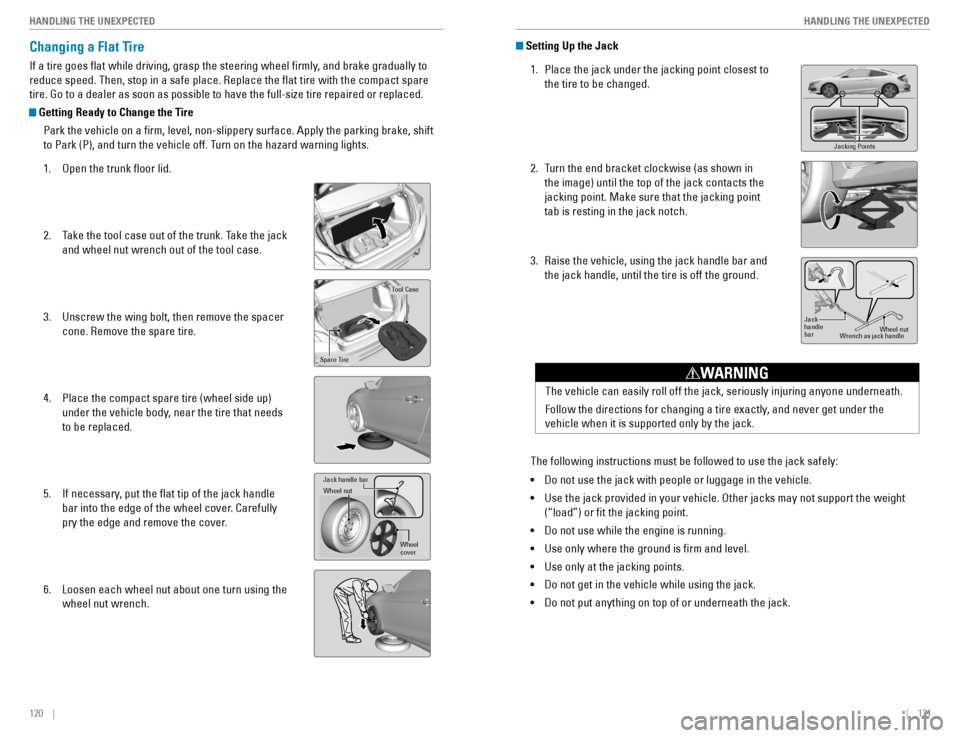
120 || 121
HANDLING THE UNEXPECTED
HANDLING THE UNEXPECTED
Changing a Flat Tire
If a tire goes �at while driving, grasp the steering wheel �rmly, and brake gradually to reduce speed. Then, stop in a safe place. Replace the �at tire with the compact spare
tire. Go to a dealer as soon as possible to have the full-size tire repaired or replaced.
Getting Ready to Change the Tire
Park the vehicle on a �rm, level, non-slippery surface. Apply the parking brake, shift
to Park (P), and turn the vehicle off. Turn on the hazard warning lights.
1. Open the trunk �oor lid.
2. Take the tool case out of the trunk. Take the jack
and wheel nut wrench out of the tool case.
3. Unscrew the wing bolt, then remove the spacer cone. Remove the spare tire.
4. Place the compact spare tire (wheel side up) under the vehicle body, near the tire that needs to be replaced.
5. If necessary, put the �at tip of the jack handle bar into the edge of the wheel cover. Carefully
pry the edge and remove the cover.
6. Loosen each wheel nut about one turn using the wheel nut wrench.
Spare Tire Tool Case
Jack handle ba
r
Wheel nu t
Wheel cover
Setting Up the Jack
1. Place the jack under the jacking point closest to
the tire to be changed.
2. Turn the end bracket clockwise (as shown in the image) until the top of the jack contacts the jacking point. Make sure that the jacking point tab is resting in the jack notch.
3. Raise the vehicle, using the jack handle bar and the jack handle, until the tire is off the ground.
Jacking Points
Jack handle bar Wheel nut
Wrench as jack handle
The vehicle can easily roll off the jack, seriously injuring anyone underneath.
Follow the directions for changing a tire exactly, and never get under the vehicle when it is supported only by the jack.
WARNING
The following instructions must be followed to use the jack safely: • Do not use the jack with people or luggage in the vehicle.
• Use the jack provided in your vehicle. Other jacks may not support the weight
(“load”) or �t the jacking point.
• Do not use while the engine is running.
• Use only where the ground is �rm and level.
• Use only at the jacking points.
• Do not get in the vehicle while using the jack.
• Do not put anything on top of or underneath the jack.
Page 65 of 82
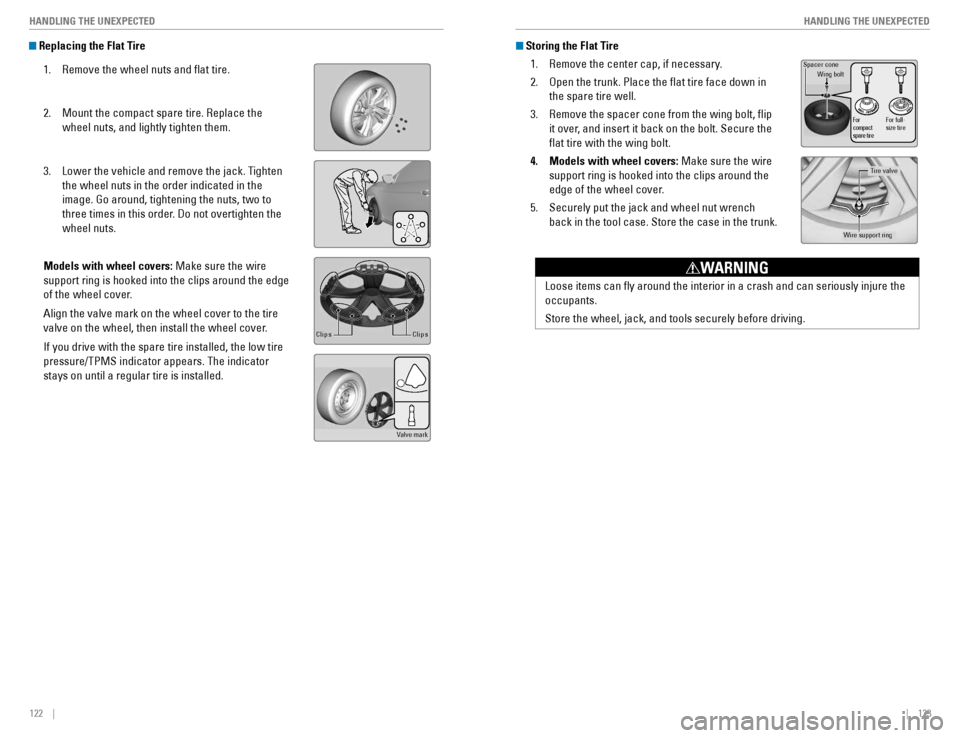
122 || 123
HANDLING THE UNEXPECTED
HANDLING THE UNEXPECTED
Replacing the Flat Tire
1. Remove the wheel nuts and �at tire.
2. Mount the compact spare tire. Replace the
wheel nuts, and lightly tighten them.
3. Lower the vehicle and remove the jack. Tighten the wheel nuts in the order indicated in the image. Go around, tightening the nuts, two to
three times in this order. Do not overtighten the wheel nuts.
Models with wheel covers: Make sure the wire
support ring is hooked into the clips around the edge
of the wheel cover. Align the valve mark on the wheel cover to the tire
valve on the wheel, then install the wheel cover. If you drive with the spare tire installed, the low tire pressure/TPMS indicator appears. The indicator stays on until a regular tire is installed.
spilC
spilC
Valve mark
Storing the Flat Tire
1. Remove the center cap, if necessary.
2. Open the trunk. Place the �at tire face down in
the spare tire well.
3. Remove the spacer cone from the wing bolt, �ip it over, and insert it back on the bolt. Secure the �at tire with the wing bolt.
4. Models with wheel covers: Make sure the wire
support ring is hooked into the clips around the
edge of the wheel cover.
5. Securely put the jack and wheel nut wrench back in the tool case. Store the case in the trunk.
Loose items can �y around the interior in a crash and can seriously injure the occupants. Store the wheel, jack, and tools securely before driving.
WARNING
Spacer cone Wing bolt
For compact
spare tireFor full -
size tire
Tire valv e
Wire support rin g
Page 74 of 82
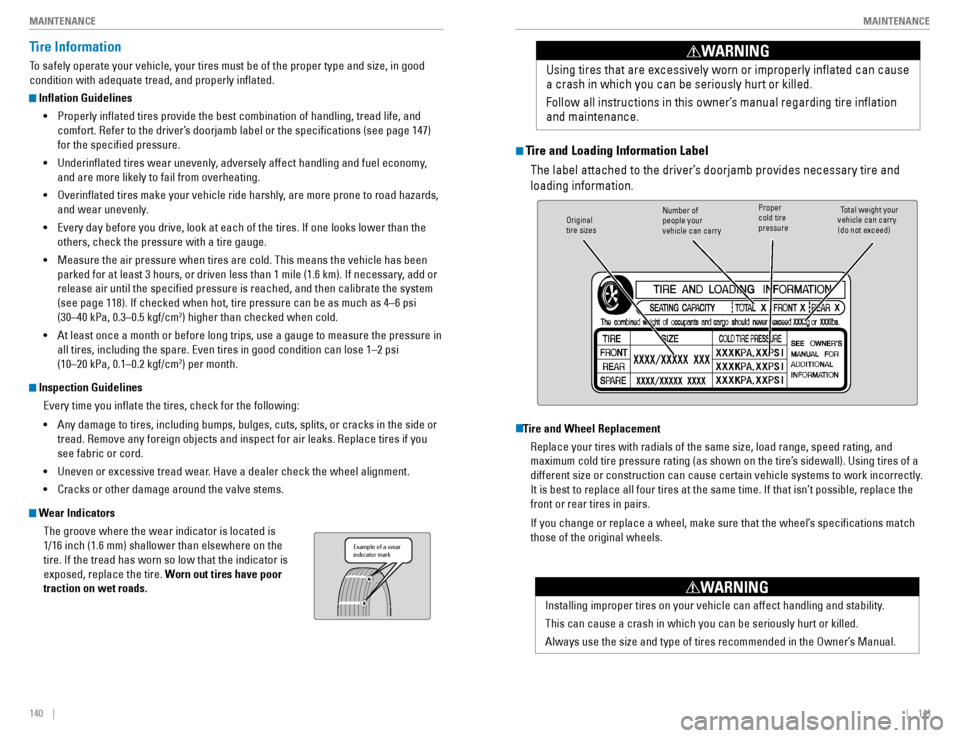
140 || 141
MAINTENANCE
MAINTENANCE
Tire Information
To safely operate your vehicle, your tires must be of the proper type and size, in good condition with adequate tread, and properly in�ated.
Inflation Guidelines
• Properly in�ated tires provide the best combination of handling, tread life, and
comfort. Refer to the driver’s doorjamb label or the speci�cations (see page 147) for the speci�ed pressure.
• Underin�ated tires wear unevenly, adversely affect handling and fuel economy,
and are more likely to fail from overheating.
• Overin�ated tires make your vehicle ride harshly, are more prone to road hazards,
and wear unevenly.
• Every day before you drive, look at each of the tires. If one looks lower than the
others, check the pressure with a tire gauge.
• Measure the air pressure when tires are cold. This means the vehicle has been
parked for at least 3 hours, or driven less than 1 mile (1.6 km). If necessary, add or release air until the speci�ed pressure is reached, and then calibrate the system
(see page 118). If checked when hot, tire pressure can be as much as 4–6 psi (30–40 kPa, 0.3–0.5 kgf/cm 2
) higher than checked when cold.
• At least once a month or before long trips, use a gauge to measure the pressure in
all tires, including the spare. Even tires in good condition can lose 1–2 psi (10–20 kPa, 0.1–0.2 kgf/cm 2
) per month.
Inspection Guidelines
Every time you in�ate the tires, check for the following: • Any damage to tires, including bumps, bulges, cuts, splits, or cracks in the side or
tread. Remove any foreign objects and inspect for air leaks. Replace tires if you see fabric or cord.
• Uneven or excessive tread wear. Have a dealer check the wheel alignment.
• Cracks or other damage around the valve stems.
Wear Indicators
The groove where the wear indicator is located is 1/16 inch (1.6 mm) shallower than elsewhere on the tire. If the tread has worn so low that the indicator is exposed, replace the tire. Worn out tires have poor
traction on wet roads.
Example of a wear indicator mark
Tire and Loading Information Label
The label attached to the driver’s doorjamb provides necessary tire and loading information.
Tire and Wheel Replacement
Replace your tires with radials of the same size, load range, speed rating, and
maximum cold tire pressure rating (as shown on the tire’s sidewall). Using tires of a
different size or construction can cause certain vehicle systems to work incorrectly.
It is best to replace all four tires at the same time. If that isn’t possible, replace the front or rear tires in pairs.
If you change or replace a wheel, make sure that the wheel’s speci�cations match those of the original wheels. Using tires that are excessively worn or improperly in�ated can cause a crash in which you can be seriously hurt or killed.
Follow all instructions in this owner’s manual regarding tire in�ation and maintenance
.
WARNING
Original tire sizesNumber of people your vehicle can carryProper cold tire pressureTotal weight your
vehicle can carry (do not exceed)
Installing improper tires on your vehicle can affect handling and stability. This can cause a crash in which you can be seriously hurt or killed.
Always use the size and type of tires recommended in the Owner’s Manual.
WARNING
Page 81 of 82
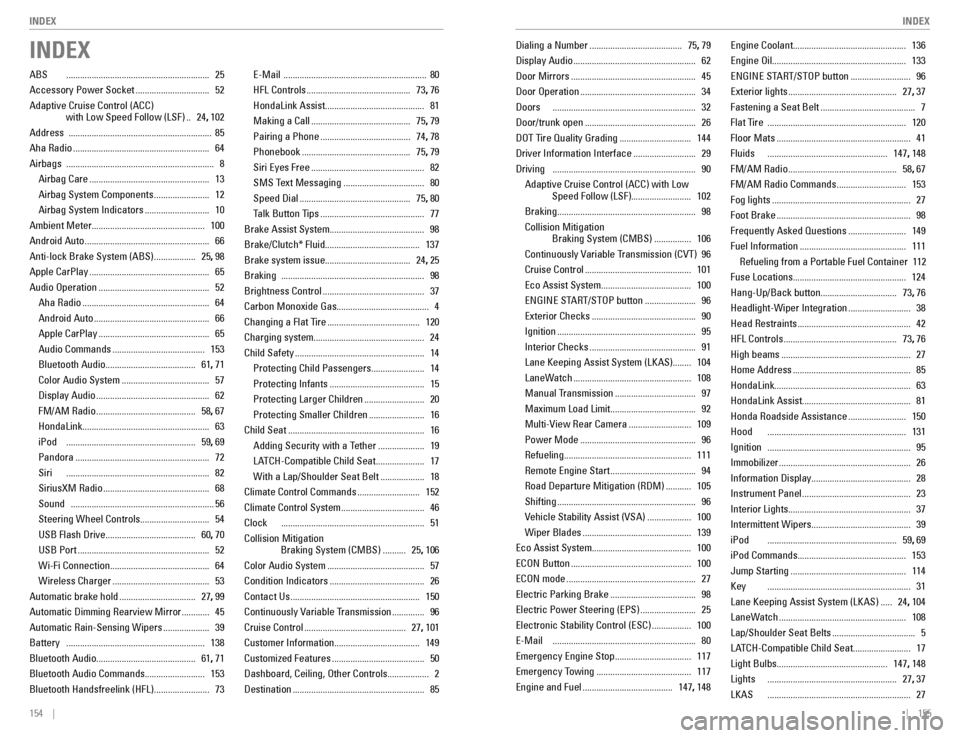
154 || 155
INDEX
INDEX
INDEX
ABS .............................................................. 25
Accessory Power Socket ................................ 52
Adaptive Cruise Control (ACC) with Low Speed Follow (LSF) .. 24 , 102
Address .............................................................. 85
Aha Radio ........................................................... 64
Airbags ................................................................ 8
Airbag Care .................................................... 13
Airbag System Components ........................ 12
Airbag System Indicators ............................ 10
Ambient Meter................................................. 100 Android Auto ...................................................... 66
Anti-lock Brake System (ABS) .................. 25, 98
Apple CarPlay .................................................... 65
Audio Operation ................................................ 52
Aha Radio ....................................................... 64
Android Auto .................................................. 66
Apple CarPlay ................................................ 65
Audio Commands ........................................ 153
Bluetooth Audio ....................................... 61, 71
Color Audio System ...................................... 57
Display Audio ................................................. 62
FM/AM Radio ........................................... 58, 67
HondaLink ....................................................... 63
iPod ........................................................ 59, 69
Pandora .......................................................... 72
Siri .............................................................. 82
SiriusXM Radio .............................................. 68
Sound .............................................................. 56
Steering Wheel Controls .............................. 54
USB Flash Drive ....................................... 60, 70
USB Port ......................................................... 52
Wi-Fi Connection ........................................... 64
Wireless Charger .......................................... 53
Automatic brake hold ................................. 27, 99
Automatic Dimming Rearview Mirror ............ 45
Automatic Rain-Sensing Wipers .................... 39
Battery ............................................................ 138
Bluetooth Audio........................................... 61 , 71
Bluetooth Audio Commands.......................... 153Bluetooth Handsfreelink (HFL) ........................ 73E-Mail
.............................................................. 80
HFL Controls ............................................. 73, 76
HondaLink Assist ........................................... 81
Making a Call ........................................... 75, 79
Pairing a Phone ....................................... 74, 78
Phonebook ............................................... 75, 79
Siri Eyes Free ................................................. 82
SMS Text Messaging ................................... 80
Speed Dial ................................................ 75, 80
Talk Button Tips ............................................. 77
Brake Assist System......................................... 98
Brake/Clutch* Fluid......................................... 137
Brake system issue..................................... 24 , 25
Braking .............................................................. 98
Brightness Control ............................................ 37
Carbon Monoxide Gas........................................ 4
Changing a Flat Tire ........................................ 120
Charging system................................................ 24 Child Safety ........................................................ 14
Protecting Child Passengers ....................... 14
Protecting Infants ......................................... 15
Protecting Larger Children .......................... 20
Protecting Smaller Children ........................ 16
Child Seat ........................................................... 16
Adding Security with a Tether .................... 19
LATCH-Compatible Child Seat ..................... 17
With a Lap/Shoulder Seat Belt ................... 18
Climate Control Commands ........................... 152
Climate Control System .................................... 46
Clock .............................................................. 51
Collision Mitigation Braking System (CMBS) .......... 25, 106
Color Audio System .......................................... 57
Condition Indicators ......................................... 26
Contact Us ........................................................ 150
Continuously Variable Transmission .............. 96
Cruise Control ............................................ 27, 101
Customer Information..................................... 149Customized Features ........................................ 50
Dashboard, Ceiling, Other Controls.................. 2Destination ......................................................... 85Dialing a Number
........................................ 75, 79
Display Audio ..................................................... 62
Door Mirrors ...................................................... 45
Door Operation .................................................. 34
Doors .............................................................. 32
Door/trunk open ................................................ 26
DOT Tire Quality Grading ............................... 144
Driver Information Interface ........................... 29
Driving .............................................................. 90
Adaptive Cruise Control (ACC) with Low Speed Follow (LSF).......................... 102
Braking ............................................................ 98
Collision Mitigation Braking System (CMBS) ................ 106
Continuously Variable Transmission (CVT) 96Cruise Control .............................................. 101
Eco Assist System ....................................... 100
ENGINE START/STOP button ...................... 96
Exterior Checks ............................................. 90
Ignition ............................................................ 95
Interior Checks .............................................. 91
Lane Keeping Assist System (LKAS) ........ 104
LaneWatch ................................................... 108
Manual Transmission ................................... 97
Maximum Load Limit ..................................... 92
Multi-View Rear Camera ........................... 109
Power Mode .................................................. 96
Refueling ....................................................... 111
Remote Engine Start ..................................... 94
Road Departure Mitigation (RDM) ........... 105
Shifting ............................................................ 96
Vehicle Stability Assist (VSA) ................... 100
Wiper Blades ............................................... 139
Eco Assist System........................................... 100ECON Button .................................................... 100
ECON mode ........................................................ 27
Electric Parking Brake ..................................... 98
Electric Power Steering (EPS) ........................ 25
Electronic Stability Control (ESC) ................. 100
E-Mail .............................................................. 80
Emergency Engine Stop ................................. 117
Emergency Towing .........................................
117
Engine and Fuel ....................................... 147, 148 Engine Coolant................................................. 136
Engine Oil.......................................................... 133
ENGINE START/STOP button
.......................... 96
Exterior lights ............................................... 27, 37
Fastening a Seat Belt ......................................... 7
Flat Tire ............................................................ 120
Floor Mats .......................................................... 41
Fluids .................................................... 147, 148
FM/AM Radio ............................................... 58, 67
FM/AM Radio Commands .............................. 153
Fog lights ............................................................ 27
Foot Brake .......................................................... 98
Frequently Asked Questions ......................... 149
Fuel Information .............................................. 111
Refueling from a Portable Fuel Container 112
Fuse Locations................................................. 124
Hang-Up/Back button................................. 73 , 76
Headlight-Wiper Integration ........................... 38
Head Restraints ................................................. 42
HFL Controls ................................................. 73, 76
High beams ........................................................ 27
Home Address ................................................... 85
HondaLink........................................................... 63
HondaLink Assist............................................... 81 Honda Roadside Assistance ......................... 150
Hood ............................................................ 131
Ignition .............................................................. 95
Immobilizer ......................................................... 26
Information Display........................................... 28Instrument Panel ............................................... 23
Interior Lights..................................................... 37
Intermittent Wipers........................................... 39iPod ........................................................ 59, 69
iPod Commands............................................... 153 Jump Starting .................................................. 114
Key .............................................................. 31
Lane Keeping Assist System (LKAS) ..... 24, 104
LaneWatch ....................................................... 108
Lap/Shoulder Seat Belts .................................... 5
LATCH-Compatible Child Seat ......................... 17
Light Bulbs................................................ 147 , 148
Lights ........................................................ 27, 37
LKAS .............................................................. 27